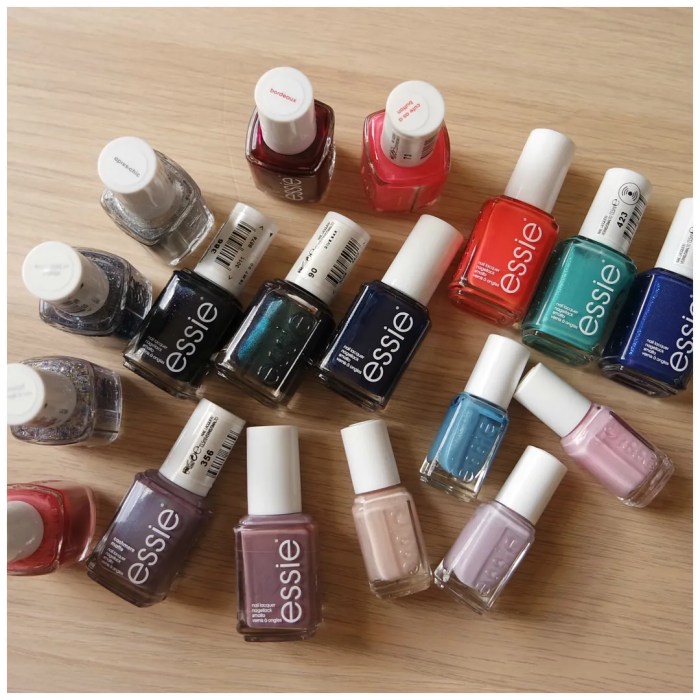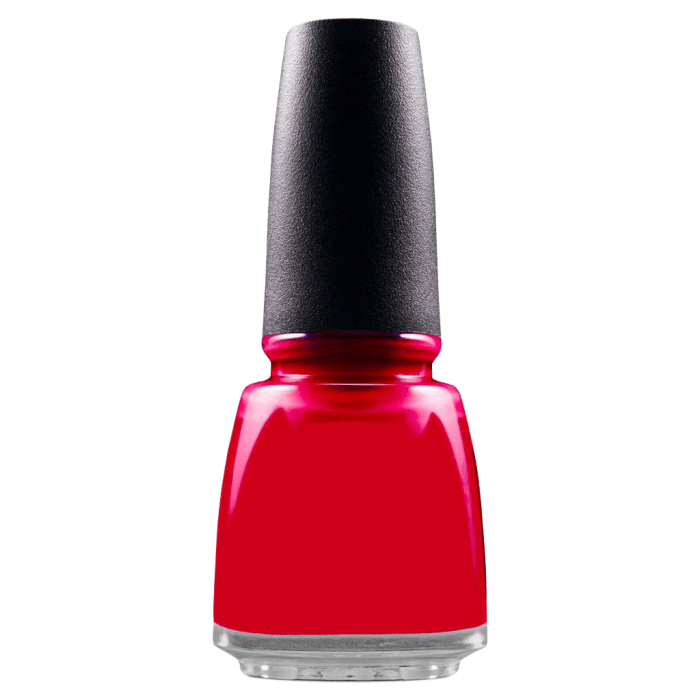What is Nail Polish A Comprehensive Guide
What is Nail Polish?
What is nail polish – Nail polish, also known as nail lacquer or enamel, is a colored liquid applied to the fingernails or toenails to decorate and protect them. It’s a cosmetic product that adds a layer of color, shine, and often, a protective barrier against everyday wear and tear.
Chemical Composition of Nail Polish
Nail polish is a complex mixture of various chemicals. The primary components include film-forming polymers (like nitrocellulose), plasticizers (like camphor and dibutyl phthalate) to increase flexibility and prevent cracking, solvents (like ethyl acetate and butyl acetate) to help the polish flow and dry, and pigments to provide color and special effects (e.g., pearlescent mica for shimmer). Other additives might include resins, antioxidants, and UV absorbers.
Types of Nail Polish
The market offers a wide variety of nail polish formulations, each with unique properties and appearances.
| Type | Description | Longevity | Special Characteristics |
|---|---|---|---|
| Crème | Solid, opaque color | 3-7 days | Classic, versatile finish |
| Shimmer | Contains fine, light-reflecting particles | 3-7 days | Subtle, sparkly effect |
| Glitter | Contains larger, more visible glitter particles | 3-7 days | Bold, dramatic look |
| Gel | Requires UV or LED light curing | 14-21 days | High shine, long-lasting |
| Matte | Non-shiny finish | 3-7 days | Modern, sophisticated look |
Historical Overview of Nail Polish
The use of colored nail treatments dates back to ancient civilizations. Ancient Egyptians used henna and other natural dyes to stain their nails. In the early 20th century, nail polish as we know it emerged, initially as a simple, often dark-colored lacquer. Throughout the decades, formulations improved, colors expanded dramatically, and specialized types like gel polish were introduced, reflecting evolving fashion trends and technological advancements.
Nail Polish Application and Removal
Applying and removing nail polish correctly ensures a long-lasting and professional-looking manicure.
Nail Polish Application Process, What is nail polish
The process typically involves several steps: preparing the nails (cleaning and shaping), applying a base coat to protect the nail and improve adhesion, applying two thin coats of color polish, allowing each coat to dry completely, and finally, sealing it with a top coat for shine and durability.
Techniques for a Smooth Finish
Achieving a smooth, even finish requires careful application. Thin coats are key to prevent bubbling and streaking. Using gentle, sweeping strokes from the cuticle to the free edge helps achieve a uniform look. Multiple thin coats are preferable to one thick coat.
Preventing Common Application Mistakes
Common mistakes like smudging can be avoided by allowing each coat to dry completely before applying the next. Bubbling can be prevented by using thin coats and avoiding shaking the bottle vigorously (instead, gently roll it between your palms).
Nail Polish Removal Methods

Source: photobucket.com
Nail polish is typically removed using acetone or non-acetone-based removers. Acetone is faster but can be harsher on the nails. Non-acetone removers are gentler but may take longer to work.
Essential Tools for a Manicure
- Nail polish remover
- Cotton balls or pads
- Nail file
- Cuticle pusher
- Base coat
- Color polish
- Top coat
Nail Polish Ingredients and Their Effects
Understanding the ingredients in nail polish is crucial for making informed choices about the products you use.
Common Nail Polish Ingredients and Their Functions
Many nail polishes contain ingredients like nitrocellulose (film former), plasticizers (for flexibility), solvents (for application and drying), and pigments (for color). Formaldehyde, toluene, and dibutyl phthalate (DBP) were commonly used but are now restricted or banned in many regions due to health concerns.
Potential Health Effects of Nail Polish Ingredients
Prolonged exposure to some nail polish ingredients can cause allergic reactions, respiratory problems, or other health issues. Proper ventilation and choosing polishes with fewer harsh chemicals are recommended.
Comparison of Ingredients in Different Nail Polish Types

Source: pngimg.com
Gel polishes, for example, often contain different photoinitiators that are activated by UV light for curing. Regular polishes rely on evaporation of solvents for drying. These differences in formulation can impact both the longevity and potential health effects.
Potential Allergens in Nail Polish
Common allergens include formaldehyde, toluene, camphor, and various fragrance components. Symptoms can range from mild irritation to severe allergic contact dermatitis.
Nail Polish Trends and Styles
Nail polish trends have evolved significantly over time, reflecting broader fashion and cultural shifts.
Timeline of Significant Nail Polish Trends
From the muted shades of the early 20th century to the bold, bright colors and intricate designs of today, nail polish trends have mirrored broader fashion movements. The 1960s saw the rise of pastel shades, the 1980s brought neon colors, and recent years have seen a surge in minimalist designs and intricate nail art.
Nail Polish Colors and Designs Reflecting Cultural and Fashion Trends
Nail polish colors and designs often reflect seasonal trends, popular culture, and even social or political events. For example, specific colors might be associated with certain holidays or celebrations.
Various Nail Art Techniques and Designs
Visual descriptions of nail art techniques could include: ombre (gradual color blending), French manicure (white tips), geometric designs (sharp lines and shapes), floral designs (intricate flower patterns), and negative space (leaving parts of the nail unpainted).
Impact of Social Media on Nail Polish Trends
Social media platforms like Instagram and TikTok have significantly influenced nail polish trends, with nail art influencers showcasing innovative designs and techniques, inspiring millions to try new looks.
The Nail Polish Industry
The nail polish industry encompasses a complex manufacturing process and supply chain.
Manufacturing Process of Nail Polish
The manufacturing process involves mixing and blending various ingredients in precise ratios, followed by quality control testing and packaging.
Stages of the Nail Polish Supply Chain
The supply chain involves raw material sourcing, manufacturing, distribution to wholesalers and retailers, and finally, reaching the end consumer.
Environmental Impact of Nail Polish and Packaging
The environmental impact of nail polish is primarily linked to the use of volatile organic compounds (VOCs) in the formulation and the packaging materials. Some brands are focusing on eco-friendly alternatives and sustainable packaging to mitigate the environmental footprint.
Ethical Considerations in the Nail Polish Industry
Ethical considerations include ensuring fair labor practices throughout the supply chain and avoiding animal testing. Many brands are now actively promoting cruelty-free and ethically sourced products.
Frequently Asked Questions: What Is Nail Polish
Can I use regular nail polish remover on gel polish?
No, regular nail polish remover is insufficient for removing gel polish. Gel polish requires soaking in acetone for removal.
How long does nail polish typically last?
This depends on the type of polish and application. Regular polish generally lasts 3-7 days, while gel polish can last 2-3 weeks.
Are there nail polishes suitable for sensitive skin?
Yes, many brands offer “3-free,” “5-free,” or even “7-free” polishes that exclude common irritants like formaldehyde, toluene, and dibutyl phthalate.
How can I prevent my nail polish from chipping?
Proper application with a base coat and top coat is crucial. Avoid using your nails as tools and consider applying a strengthening treatment to your nails.















